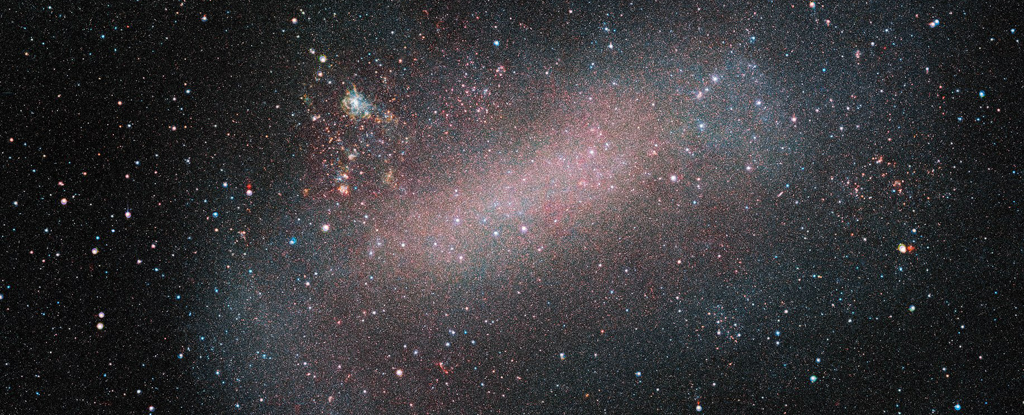Certainly! The Large Magellanic Cloud (LMC) is a fascinating astronomical object that has captured the attention of astronomers and stargazers alike. In this article, we will explore what the LMC is, its characteristics, how it was discovered, and what makes it so interesting.
 |
| Exploring the Mysteries of the Large Magellanic Cloud |
What is the Large Magellanic Cloud?
The Large Magellanic Cloud is a satellite galaxy of the Milky Way, located about 163,000 light-years away in the constellation Dorado. It is one of the closest galaxies to our own and is about 14,000 light-years in diameter. Despite its relatively close proximity, the LMC is only visible from the southern hemisphere, making it difficult to study for astronomers in the northern hemisphere.
The LMC is classified as a dwarf irregular galaxy, which means that it has no defined shape or structure. It contains a large number of gas clouds and young stars, which are constantly forming and evolving. These young stars are often hot and bright, giving the LMC a blue hue.
Characteristics of the LMC
The Large Magellanic Cloud has a number of interesting characteristics that make it unique among galaxies. One of its most notable features is the Tarantula Nebula, a large and bright emission nebula located in the southern part of the LMC. The Tarantula Nebula is a site of active star formation and contains some of the brightest and most massive stars in the known universe.
Another interesting feature of the LMC is its bar structure. The LMC has a central bar of stars that is about 5,000 light-years long. This bar is surrounded by a disk of gas and stars, which contains the majority of the LMC's young stars and star-forming regions.
The LMC also contains a number of globular clusters, which are large and dense collections of stars that are thought to have formed early in the history of the galaxy. The LMC has about 60 known globular clusters, which is a relatively large number for a galaxy of its size.
Discovery of the LMC
The Large Magellanic Cloud was first discovered by European explorers in the early 16th century. The Portuguese explorer Ferdinand Magellan and his crew observed the LMC during their journey around the world and named it after their captain.
The LMC was later observed and studied by a number of astronomers, including the French astronomer Nicolas Louis de Lacaille in the mid-18th century. Lacaille made detailed observations of the LMC and cataloged a number of its features, including its position and size.
In the 20th century, the LMC became a popular target for astronomers studying the structure and evolution of galaxies. It was studied extensively by astronomers using a variety of telescopes and instruments, including the Hubble Space Telescope.
Why is the LMC interesting?
The Large Magellanic Cloud is an interesting object for a number of reasons. One of the main reasons is that it is one of the closest galaxies to our own, and is, therefore, an important object for studying the evolution and structure of galaxies.
The LMC is also interesting because of its large number of young stars and star-forming regions. These young stars are important because they can provide clues about the early stages of star formation and the conditions that are necessary for stars to form.
The Tarantula Nebula, which is located in the LMC, is also of interest to astronomers. This nebula contains some of the most massive stars in the known universe and is a site of active star formation. Studying the Tarantula Nebula can therefore provide insights into the processes that govern star formation and the evolution of young stars.
Finally, the LMC is interesting because of its role in the history of astronomy. It was one of the first extragalactic objects to be studied in detail and was a source of inspiration for a number of important discoveries in the field of astronomy. For example, the study of the LMC played a key role in the development of the distance ladder, which is a method used by astronomers to measure the distances to objects in the universe.
In addition to its scientific importance, the Large Magellanic Cloud is also a popular target for amateur astronomers and stargazers. Because of its relatively close proximity, it is one of the few galaxies that can be seen with the naked eye. It is also a popular target for astrophotography, with many stunning images of the LMC taken by both amateur and professional photographers.
Conclusion
The Large Magellanic Cloud is a fascinating object that has captured the attention of astronomers and stargazers for centuries. Its proximity to our own galaxy, its large number of young stars and star-forming regions, and its role in the history of astronomy all make it an important object of study.
As astronomers continue to study the LMC, they will undoubtedly make new discoveries and gain new insights into the structure and evolution of galaxies. And for those of us who simply enjoy looking up at the night sky, the LMC will continue to inspire and captivate us with its beauty and mystery.


0 Comments